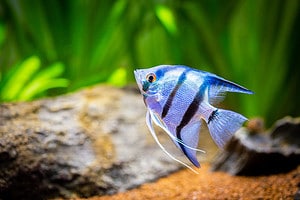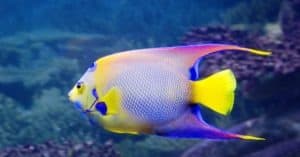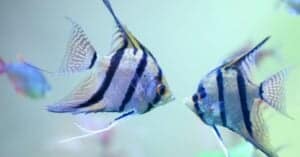Angelfish are marine perciform fish that generally live in shallow reefs, commonly seen by snorkelers and divers. There are two groups of fish known as angelfish, including freshwater and aquatic species. Freshwater angelfish originate in South America through the Amazon river and are commonly kept as pets. But the marine angelfish are considered a completely separate family of fish, sharing only the popular name with their freshwater namesakes. It’s important not to confuse the two as they are not closely related. Today, we will be covering the diets and behaviors of marine angelfish. With 86 distinct species, there is a lot to learn! Let’s discover: What Do Angelfish Eat?
What do angelfish eat?

Angelfish are rather opportunistic eaters, but they do have some favorite foods. Classified as an omnivore, angelfish will eat everything from small plants all the way up to shrimp. Let’s look at it in some more detail.
Since there are so many species of angelfish, their diets will mostly depend on their location and their size, with size being the most important factor of the two. The smallest species of angelfish generally stick to small prey, mostly things like algae and plankton. Since those prey sources are plentiful, they constitute much of a small angelfish diet.
As they get larger, angelfish are able to diversify their diets. Medium to large angelfish are known to feed on tunicates, sponges, jellyfish, and bryozoa. Tunicates are marine invertebrates that generally stick to rocks, filtering seawater and eating plankton. Jellyfish and hydroids (small creatures related to jellyfish) also make up portions of their diet.
Sponges are probably the most dominant food element of angelfish, with some exclusively eating sponges. The holocanthus angelfish, for example, is a species of angelfish that exclusively eats sponges, even in a captive setting. Additionally, small crustaceans are common prey items for larger angelfish, but it is only possible when they reach a certain size. Smaller fish simply don’t have the mouth size to prey on shrimp, crabs, or other crustaceans.
A complete list of foods angelfish eat
Here is a complete list of foods that angelfish eat:
- algae
- sponges
- jellyfish
- plankton
- bryozoa
- tunicates
- shrimp
- small crabs
- other small crustaceans
- specailized fish foods in an aquarium setting
How do angelfish get their food?
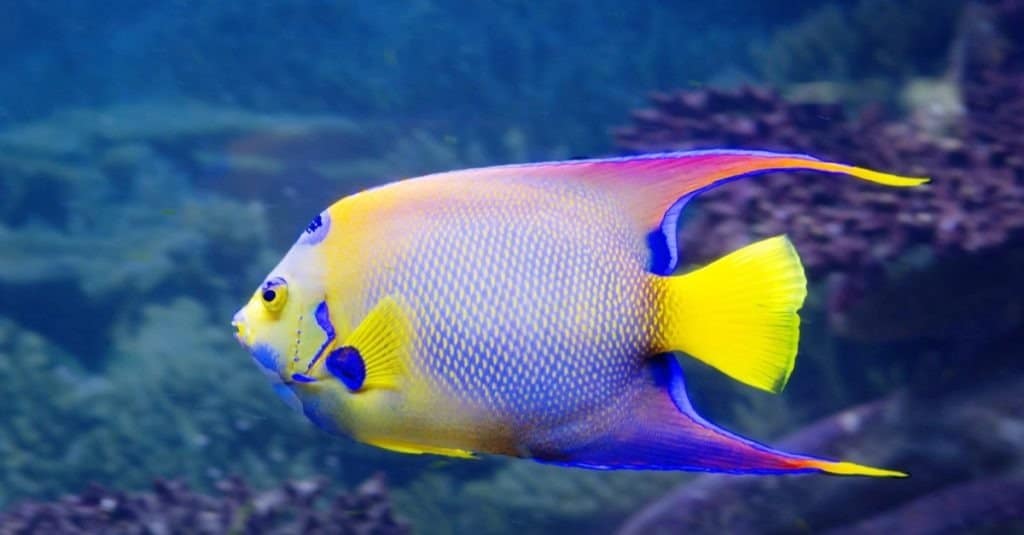
Angelfish often help reef ecosystems by eating fast-growing
corals
that could take over.
©Galina Savina/Shutterstock.com
Angelfish are general predators, eating things that are easily within their reach. Their hunting strategy is simple, especially since most of their primary food sources are either slow-moving or totally motionless. Angelfish have small mouths that mostly correlate to their specific species and preferred foods.
They are known as fearless fish and often approach divers and snorkelers without much worry. Generally diurnal fish, they spend their active hours during the day feeding or looking for food. They hole up in crevices and holes during the night, hoping to avoid predators.
One of the most important roles an angelfish plays in their ecosystem is to reduce the spread of fast-growing corals in a reef. Since much of their diet is sponge-based, and of that mostly fast-growing sponges, they play a critical role in keeping fast-growing corals and spongs from taking over entire reef ecosystems.
Where do angelfish live?
Angelfish are found all over the world, primarily congregating in reefs in tropical oceans. They are most commonly found in shallow reefs in the tropical waters of the Atlantic, western Pacific, and Indian oceans. There are 86 species of angelfish, all with their preferred habitat and range. They are known as incredibly hardy fish, able to sustain quick and large variations in pH levels, temperatures, and more. Additionally, they are known to live up to 25 years, making them a rather long-lived fish.
Angelfish are generally brightly colored, but they don’t always stand out since the places they live are often so colorful. Still, they prefer reefs and don’t often go past 160 feet down. There have been some species found deeper, such as the Centropyge abei, but it is significantly less common.
What animals compete with angelfish for food?
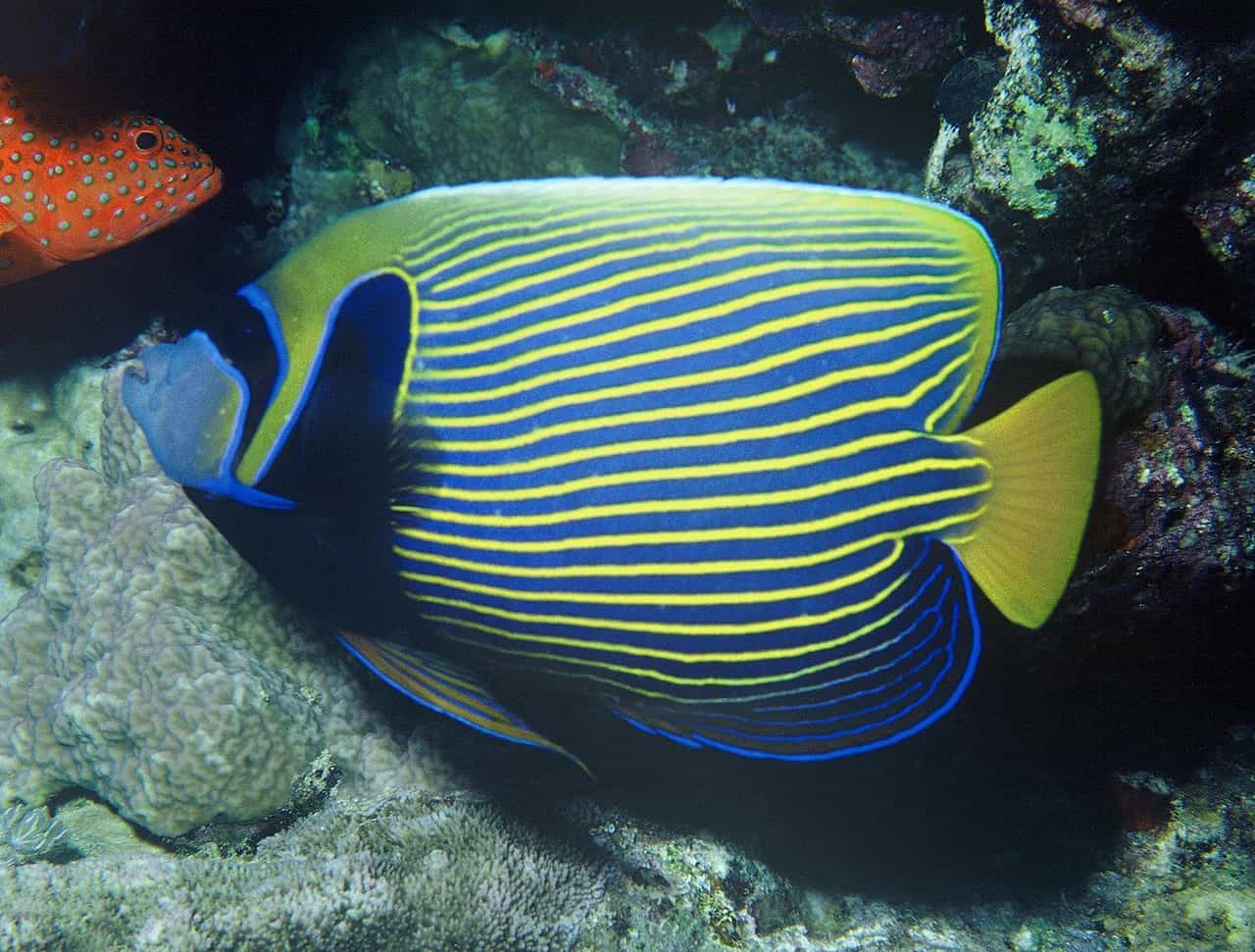
Angelfish compete for resources both within their species and with sponge-eating fish like boxfish and
wrasses
.
©Albert Kok, Public domain, via Wikimedia Commons – License
Angelfish compete with other sponge-eating fish within a reef ecosystem. With how many resources that have historically been available in reefs, however, this competition is slight. Young and juvenile angelfish occasionally spend their early lives acting as cleaner fish, especially when their size puts them at risk in their reef environments. The angelfish that operate as cleaners will simply stick around huge fish, clearing off parasites and other organic material. They are usually protected by the size of the fish they are helping. This behavior generally doesn’t last into maturity; it is done as a way to make it to adulthood.
Outside of inter-species competition, there are other fish that prey on angelfish as a food source. Barracuda, sharks, and larger fish are common predators.
What do you feed a pet angelfish?

Pet angelfish can eat marine flakes, brine shrimp, and algae.
©PAUL ATKINSON/Shutterstock.com
Angelfish were once a rare aquarium fish, often selling for thousands of dollars per breeding pair. In addition to becoming more popular, they have also become more affordable, so many now keep them in their home aquariums. Having an angelfish in a tank isn’t too tough, but there are a few things that should be noted when feeding one.
The first thing to be aware of is their species. Every angelfish species has different dietary and tank needs. Generally, however, having plenty of algae growing on rocks and coral is an important first step since algae is a food source for most angelfish.
For some carnivorous species, marine flakes with vitamin enhancements and color enrichment are great for simulating natural feeding environments. Additionally, brine shrimp can be purchased and added, along with other chopped frozen crustaceans like full-sized shrimp or crab.
Additionally, it’s important to know that many angelfish will attack and kill some budding corals, clams, and polyps, damaging an aquarium’s ecosystem. Be aware of your tank and your fish before adding them to an established environment.
The photo featured at the top of this post is © Paul Hermans, CC BY-SA 3.0, via Wikimedia Commons – License / Original
Thank you for reading! Have some feedback for us? Contact the AZ Animals editorial team.



